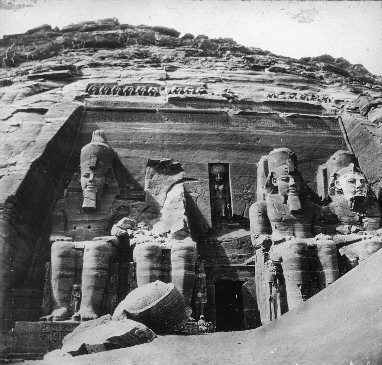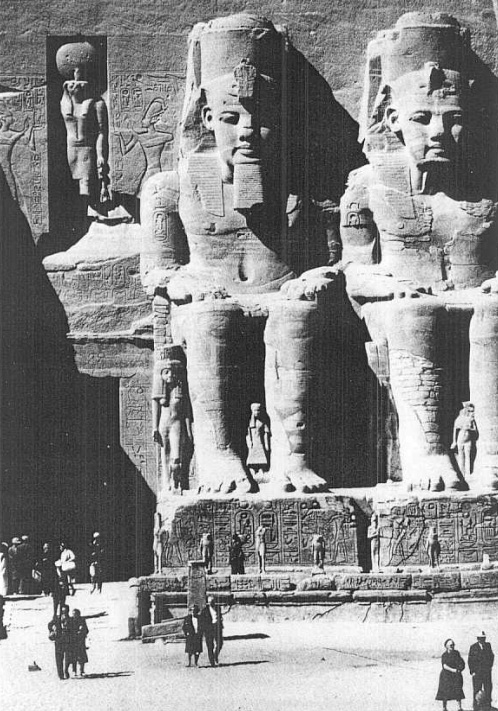Fashback: The relocation of Egypt’s Abu Simbel temples
The the Pharaonic monuments in Aswan, known as Abu Simbel temples, were originally carved out of the mountainside during the reign of Pharaoh Ramesses II in the 13th century BCE (Before the Current Era).
Not only are the two temples at Abu Simbel among the most magnificent monuments in the world but their removal and reconstruction was an historic event in itself. When the temples (280 km from Aswan) were threatened by submersion in Lake Nasser, due to the construction of the High Dam, the Egyptian Government secured the support of UNESCO and launched a world wide appeal. During the salvage operation which began in 1964 and continued until 1968, the two temples were dismantled and raised over 60 meters up the sandstone cliff where they had been built more than 3,000 years before. Here they were reassembled, in the exact same relationship to each other and the sun, and covered with an artificial mountain.
Several other ancient monuments were relocated in the 1960s as part of a UNESCO campaign to save Egyptian monuments threatened by the establishment of the Aswan High Dam.
The Temple of Re-Harakhte (The Sun Temple of Ramsis II)
The main temple was dedicated to Ramsis II and to the four universal gods Ptah, Re-Harakhte, Amun-Re, and to Ramsis II himself. Of the seven temples he built, Abu Simbel is considered to be the most impressive.
Above the doorway in a niche stands the sun god, a falcon headed representation of Ramsis, holding a war-scepter which shows the head and neck of an animal which is read as user, in his right and a figure of Ma’at in his left. This setup ingeniously creates the Kings Throne name of User-Ma’at-Re. At the top of the facade is a row of baboons which are thought to be greeting the morning sun and indeed the monument looks best at that time. The sides of the thrones next to the entrance are decorated with Nile gods symbolically uniting Egypt, while below are prisoners, representing conquered nations, to the left, African and to the right, Asian.
The entrance leads into a Grand Hall which is 57 feet high and 52 feet wide and was cut from the rock. It is supported with eight pillars with statues of Ramsis.
To either side of the Grand Hall are smaller rooms, two to the South and four to the North. Most suggest that these rooms were for storage (treasure rooms) but elsewhere it is suggested that they were used for festivals related to the Kings Jubilee.
Beyond the Grand Hall is the second hypostyle hall with its flowered pillars. Scenes in this hall show the King and his wife, Nefertari making offerings to Amun and Re-Harakhte (the Sun God), and beyond that is the three chapels, the central one containing the four deities worshipped in the temple (including Ramsis II).
The sun shines on the face of the statue on February 22 and October 22 every year, the birthday and date of the coronation of Ramses II.
Nefertari’s Temple of Hathor (Abu Simbel – Small Temple)
Hathor was the wife of the Sun God so in a symbolic way, the two Temples, that of Ramsis II and that of Nefertari, brings Ramsis II and Nefertari and Hathor and the Sun God together as one. The facade of the temple is a receding Pylon, just as the larger temple of Ramesses II. On either side of the entrance to the temple is a deified statue of Nefertari with statues of Ramsis II on either side of her. The statues of Nefertari are the same height as those of Ramsis, which is unusual. Like at Ramsis II’s temple, there are children depicted around their feet. There are cobras protecting the Temple door.
This temple is much simpler than the Temple of Re-Herakhte. It has only one hypostyle hall and the sanctuary. Within the hall are images of Ramsis in battle with Nefertari present. Other scenes depict Ramsis being crowned by Horus and Seith and presenting Ma’at to Amun. On the back wall, Nefertari is before Hathor and Mut. Just behind the Hypostyle Hall is a small chamber with images of Hathor cow framed in reeds. Beyond that is the sanctuary with a divine cow emerging from the rear rock wall protecting Ramsis, below her. Above the cow, vultures guard the Queens cartouches. Other scenes show Nefertari offering incense to Mut and Hathor, and the King worshipping before his own image and that of Nefertari.
Ramses II

He was born ca. 1302 BC. At age fourteen, Ramses II was appointed Prince Regent by his father.
He is believed to have taken the throne in his early 20s and to have ruled Egypt from 1279 BC to 1213 BC for a total of 66 years and 2 months.
Ramses II was the third king of the 19th dynasty, and the second son of Seti I and his Queen Tuya. The most memorable of Ramses’ wives was Nefertari. Earlier wives, among others, were Isisnofret and Maathorneferure, Princess of Hatti.
Ramses II also campaigned south of the first cataract into Nubia. He constructed many impressive monuments, including the renowned archeological complex of Abu Simbel, and the mortuary temple known as the Ramesseum. It is said that there are more statues of him in existence than of any other Egyptian pharaoh, not surprising as he was the longest-reigning pharaoh by many years.
Source: Egypt -State Information Service
_________
Wall Painting of Temple of Beit El-Wali (Plaster Cast), which Ramses II Constructed in Nubia – British Museum
click image below to enlarge

_________
Floor plan
Since the two Abu Simbel temples had to be removed from their original sites- beyond the reach of the future Lake Nasser- a careful documentation of the Temples on those sites was carried out, mainly by numerous measurement drawings and photographs.

A computer rending of the original interior mountain floor plan of how the original temple would have looked be before it was flooded and relocated

Photos of the original location of the two Abu Simbel temples before being relocated

The original interior of temple was craved inside the mountain
Between 1955 and 1963 archaeologists extensively photographed the original interior of the Great Temple of Abu Simbel.

The relocation of Abu Simbel
Artist rendering of how they expected to relocate the temples to higher ground

Building the concrete dome for the artificial mountain that now houses the interior cave temple

Sawing out portions of the original temple for relocation

Current location
View showing the interior of the artificial concrete mountain and the exterior shell of the relocated cave temple

Model showing the relationship of the current water level and the original ancient temple
Construction of Sadd El Aali, the High Dam on the Nile 4.34 miles south of Aswan, was started in 1960.
From 1964 on, the water level of the Nile was to be gradually raised, in order to create an enormous reservoir -the current Lake Nasser -with a maximum water level some 196.85 feet higher than previously located or about 15 stories higher than the original temple.

______
Lake Nasser flood ancient Egyptian temples and African artifacts
Philae Temple
South of the city of Aswan lies the beautiful temple complex of Philae (pronounced “feel-i”). Its main temple was dedicated to the goddess Isis and its construction was undertaken during the third century B.C. Philae was the last bastion of ancient Egyptian religion and hieroglyphic usage. It is also a superb example of threatened cultural heritage being saved in the face of modern civilization’s march to change the environment.
The island of Philae and its temples came under threat at the turn of the century when the British erected the Aswan Dam at the First Cataract. Philae began to spend some of its time beneath the backed-up flood waters of the Nile.
Philae Temple were flooded by Aswan High Dam. The Egyptian government with cooperation of UNESCO.
Philae was saved from drowning. In 1977, a coffer dam was constructed around the temples and the water was pumped out. Then the temples were dismantled with every block assigned a number and its position noted. A nearby higher island called Agilkai was modified to resemble Philae and the temples were resembled. In 1980, Philae was once again opened to the public.
Anything not discovered was flooded.
Source: Egypt -State Information Service
Relocated Philae Temple

__________
Nile in Nubia (Kush) or Sudan
Potential flooding of Ancient Kush (Nubia) may have already covered over ancient African artifacts.
The Merowe Dam, also known as Merowe High Dam was construction began 2004 and opened March 3, 2009.
The construction of a new dam at the Fourth Nile Cataract has resulted in a major international rescue campaign.
The Sudanese government has recently secured construction contracts for several dams.
Temple at Soleb- Sudan (Kush) built by the Pharaoh Amenhotep III

_________
Video: The Temple of Soleb
_________



























April 13, 2015
Africa, Did you know?, Religion & Spirituality, Remember yesteryear